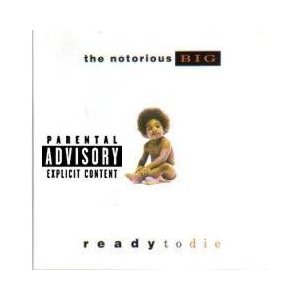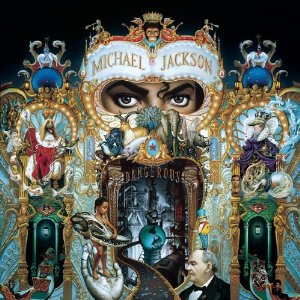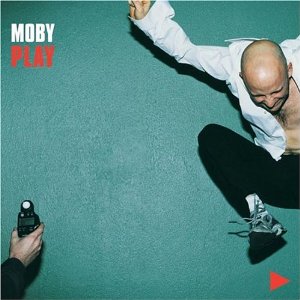30. Moby | Play (released 6/1/99 on V2 Records | 2.7 million)
By the time Play was released in 1999, Moby’s career had been left for dead. After becoming a dance and electronic music sensation with his early singles and 1995’s brilliant Everything Is Wrong album, he confounded critics and alienated fans with 1996’s Animal Rights, a straight up punk rock record. In the aftermath of the backlash from Animal Rights, he was left with a dwindling fan base and without his major label deal.
So few took notice when Play first hit stores. It took almost a year before things blew up, mostly thanks to an unprecedented licensing campaign that resulted in every song off the album being licensed for use in movies, commercials, television shows, you name it. Suddenly Play songs became inescapable, the album rose up the charts and Moby was on his way to becoming electronic music’s first superstar. MTV started playing the videos from the album in heavy rotation, increasing exposure to the album even more.
Mixing Alan Lomax’s field recordings with his brand of downtempo electronic, Moby scored hits with tracks like “Natural Blues”, “Why Does My Heart Feel So Bad?” and “Honey”. There were outstanding rock/electro hybrids like “Bodyrock”, “Machete” and the smash hit “South Side”, as well as quieter, ambient pieces such as “My Weakness”, “The Sky Is Broken” and “Everloving”. And the brilliant “Porcelain” mixed all of those elements together into one of the album’s highlights. In all nine singles were pulled from Play, it went on to sell over ten million copies worldwide and single-handedly saved Moby’s career.-Mike A.
29. Foo Fighters | The Colour and the Shape (released 5/20/97 on Roswell/Capitol Records | 2.3 million)
The debut Foo Fighters album showed the world the musical genius inside Dave Grohl’s head, with 11 of ther 12 tracks recorded in their entirety by Grohl and Grohl alone. The follow-up marked the debut of the Foo Fighters as a full band, while simultaneously creating what many argue to be the essential Foo album. The “big three” singles of the album are classics in the truest sense of the word, yet all in different ways. “Monkey Wrench” shoots full speed ahead with its rock and roll bombast, while the triumphant “My Hero” celebrates every day people with its anthemic guitar and tom-heavy drums. The album’s most celebrated track, the powerful “Everlong”, mixes an incredible drum part with a catchy, staccato guitar line and Grohl’s impassioned lyrics in one of the best love songs of the decade. But the rest of the album holds up as well, from the acoustic lulls of “Walking After You” to the spacey delays and muddy bass of “Enough Space”, to classic rock guitars of “Hey, Johhny Park!” Most importantly, however, this was the album that once and for all solidified Grohl as a rock legend in his own right.-Stephen
28. Janet (Jackson) | The Velvet Rope (released 10/7/97 on Virgin records | 3.2 million)
The Velvet Rope continued Janet Jackson’s run of eclectic, tantalizing collaborations with Jimmy Jam and Terry Lewis that started with 1986’s Control. Jackson opens the album with a spoken piece stating “It’s my belief that we all have the need to feel special”, before opening herself up like never before in a 16 song examination of love, loss, sexuality, depression and the human condition.
The subject matter on The Velvet Rope could be heavy at times. The stunning title track expounded on our need to feel special and loved, “What About” is a searing look at domestic violence alternating between lovely verses and an angry rocking chorus, “Together Again” was a dedication to friends and associates Jackson had lost to AIDS set to a light dance beat and “Free Xone” took on homophobia.
But it also took the sexual awakening Jackson first touched on during her previous album Janet to new heights with explorations of S&M on “Rope Burn”, a same sex affair on “Tonight’s The Night” and do I really need to explain the meaning of a song called “Go Deep”? Jackson’s penchant for first-class ballads continued as well from the R&B thump of “I Get Lonely” to the luscious piano ballad “Every Time”, a brutally honest admission of fear of giving your heart to another after being hurt before. Although it may not have sold as well as her previous few albums, The Velvet Rope was an artistic high point for Janet.-Mike A.
27. Metallica | Metallica (released 8/12/91 on Elektra Records | 15.7 million)
20 years ago on August 12, 1991, at the tender age of 16 years old, donned in a pair of oversized, ill-fitting shorts and a Megadeth t-shirt, I drove myself to Kemp Mill Records in Vienna, VA to purchase the new self-titled release from one of my musical heroes, Metallica. I walked in the store and began scanning the display shelves up front where I knew the CD (in a long box no less) would be situated. After being in the store about 15 seconds I heard a “Hey!” from the clerk behind the register and turned to see a Metallica CD sailing through the air at me. I caught it and studied the cover art and the track listing and then plunked down my $12.53 (yes, I remember exactly how much I used to pay for albums back then) and anxiously drove home in my two door, dark green Volvo DL (which was equipped with only a cassette player) to crank this bad boy on my portable CD player that was hooked up to my boombox. Having already heard the lead single “Enter Sandman”, which was a departure from the Metallica I had grown to know and love over their first four albums, I had a feeling this album would be a new direction for the band. Producer Bob Rock, who was known for working with bands like Motley Crue, Bon Jovi and Blue Murder, had been brought on board to produce the album and his influence is clear. This was Metallica at their loudest, heaviest and hookiest yet. Many fans were extremely disappointed with the lack of speed the album showed, but others, like myself, couldn’t help but be in awe and massive radio and MTV exposure opened the band up to an even wider audience. The album produced 5 HUGE singles: “Enter Sandman”, “Sad But True”, “The Unforgiven”, “Nothing Else Matters” (not only an uncharacteristically light ballad, but a love song no less!) and “Wherever I May Roam” and carried the band through years of grueling world wide touring in support of the album. With this release, Metallica arrived and cemented themselves as their generation’s Led Zeppelin. Napster lawsuits and ill-conceived collaborations with Lou Reed notwithstanding, Metallica has built up one of the most fiercely loyal fan bases of any band in history. While musical styles and trends come and go, Metallica has been immune to them and is easily the biggest rock band in the world. This is the album that was the first tremendously large step to that new plateau, thus making it not only one of the Top 100 Albums of the ’90s, but one of the Top 100 Albums of All-Time.-Nick
26. Nas | Illmatic (released 3/29/94 on Serchlite/Columbia Records | 1.5 million)
I’ve heard it said that The Low End Theory is the Sgt. Pepper’s of hip hop. If that’s the case (and I believe it to be), then Illmatic is Dark Side of the Moon. You know, that album that changed the way you perceived things….the album you bought multiple copies of due to the wearing out of the others? You know what I mean…..the album that you can’t start somewhere in the middle, because you need to play it front to back because every song is a classic? Yup, that’s Illmatic.
Arguably the greatest hip hop album ever produced, Nasty Nas’s debut is perfection personified. With a bulk of the tracks built by the Mt. Rushmore of production (Pete Rock, Q-Tip, Large Professor & Premier), Nas’s lyrics, flow and ferocious hunger combine to create some true next-level stuff. All apologies and respect due to the greats, but no emcee has ever put together such a collection of brilliant lyrics as Nas did on Illmatic. The book of rhymes he talks about on “It Ain’t Hard to Tell” needs to be enshrined in the Smithsonian and recognized for what this work truly is: a masterful work of American poetry. Scenes of shootouts, Rikers Island visits, corners, hot-spots and every day life in the struggle in Queensbridge are woven seamlessly and illustrated perfectly with each swipe of the pen. From the opening scene straight out of Wild Style, to the very last note, Illmatic is just….well…..Illmatic.-Chuck
 25. The Notorious B.I.G. | Ready To Die (released 6/17/94 on Bad Boy/Arista Records) | 3.6 million
25. The Notorious B.I.G. | Ready To Die (released 6/17/94 on Bad Boy/Arista Records) | 3.6 million
Not content to merely be a fiery opening salvo for the storied (albeit brief) career of Biggie, Ready to Die encapsulates all of the rapper’s legendary strengths – gritty street-level narratives, plus-sized loverman come-ons, an astonishing rhyme acuity that manages to be direct and accessible even as it defies easy flows and rhyme schemes, and a captivating, charismatic mic presence – in one sprawling, remarkably chiseled package. Interesting, too, that Ready to Die might be a lot darker than you recall – sure, victory-lap “Juicy” and lusty party-rocker “Big Poppa” retain their breezy, head-nodding verve 17 years on, but moments of joy are interspersed with vivid crime stories that never end well, and the heart-stopping shot that rings out at the end of “Suicidal Thoughts” is as sobering and thoughtful as any cinematic drama. Strange, that an album so lively could be so preoccupied with the finality of death, but then, that’s the world that the legendary Biggie inhabited. – Drew
24. Red Hot Chili Peppers | Blood Sugar Sex Magik (released 9/24/91 on Warner Bros. Records | 4.7 million)
Blood Sugar Sex Magik wasn’t RHCP’s debut album, but it may as well have been. They’d released four good-to-excellent records beforehand, truth be told, and as of this writing have released five good-to-excellent records since, but regardless of which one is your favorite, BSSM remains the purest distillation of their sound, and a record that bridges the gap between the freewheeling party boys of yore and the thoughtful, textured songwriters of late. Youthful idealism, sex tempered with romanticism, and cautious partying remain the order of the day here, but as RHCP attempt to infuse a more mature direction into their single-minded, party-hearty playbook, they introduce an expert melodic sense into the proceedings, allowing their excellent ballads (“Breaking the Girl”, “I Could Have Lied”, the still-great “Under the Bridge”) space to breathe between lurching, squalling slabs of funk-rock (“Give It Away”, “The Righteous and the Wicked”, the wickedly nasty “Sir Psycho Sexy”). The melange is infectious, still largely different from anything that’s come since, and, for one glorious album of thick, gooey basslines and squealing guitar solos, stated a compelling case for RHCP as heirs apparent to the funk-rock throne vacated by Funkadelic. – Drew
23. Foo Fighters | Foo Fighters (released 6/20/95 on Capitol Records | 1.5 million)
So the drummer from Nirvana is venturing out behind the kit to form his own band? What’s it going to sound like? Am I going to like it? How do you escape the shadow of a band like Nirvana? Well, you put your best foot forward, you put the guitar pedal to the floor and you make damn sure you rock.
Such was the case as the sound of the guitar connects to the amp and the monkeyshine drums come banging in on “This Is a Call”. With a pop sensibility that intentionally eluded Nirvana’s music, Dave Grohl attacked radio airwaves in the spring of 1994. “I don’t owe you anything…” Grohl sings with such fervor on “I’ll Stick Around”. It’s almost his mission statement for what has transpired over the next 17 years. The Foo Fighters have been about as much a part of American rock music culture as any band with a long trajectory. Their mark has exceeded Nirvana’s in terms of discography, but this was the opening salvo. It’s still my favorite Foo album from start to finish. It’s also, with all due respect to this year’s Wasting Light their hardest, purest album. The youthful exuberance that wasn’t full spent on Nirvana’s tenure, is put to good use on “Alone + Easy Target”, “Weenie Beanie”, “Wattershed”, and “Exhausted”. Amidst all of the fuzz the Foo’s could muster up, they still find time to open the door to a pop rock existence by way of “Big Me” and “Oh, George”. One giant leap for Dave Grohl, one small step for mankind…-KBOX
22. Jeff Buckley | Grace (released 8/23/94 on Columbia Records | 944K)
So rare is the individual that enters the public realm as a fully-formed artist that Jeff Buckley’s Grace was birthed sounding like the work of a seasoned veteran. In reality, it was Buckley’s first proper album, and also his last: a drowning accident robbed us of Buckley’s talent before he was finished crafting his follow-up. What remains is Grace, a purposeful, mysterious, work of staggering beauty – it clocks in at a lean ten songs, each ably navigating us through the landscape of Buckley’s influences, synergizing Van Morrison’s mysticism, Nina Simone’s soul, and Robert Plant’s forceful wail into a sound that remains astoundingly accomplished, and, perhaps more interestingly, unique and fresh, unduplicated even as the man’s legacy has caught fire. Listening to Buckley’s octave-scaling croon on the swooningly romantic “Lover, You Should’ve Come Over”, his mesemerizing classical bent on “Lilac Wine” and “Corpus Christi Carol”, or his reverbed, minimalist guitar and fragile vocal on what is now and forever the only official version of Leonard Cohen’s “Hallelujah”, thankyouverymuch, two things are clear: if you could bottle moonlight and convert it into audio files, it would sound a lot like this, and most importantly, for a performer plucked from us far too soon, Grace sounds full of wonder and promise, and remarkably alive. – Drew
 21. Michael Jackson | Dangerous (released 11/22/91 on Epic Records | 6.4 million)
21. Michael Jackson | Dangerous (released 11/22/91 on Epic Records | 6.4 million)
In 1991, the release of a Michael Jackson album was still a big deal, although Dangerous may have been the last such release of MJ’s career. Already a master of the music video art form, Jackson continued to attempt to one up himself in the video format, bringing in a slew of guest stars (Magic Johnson, Eddie Murphy, Iman, Naomi Campbell, Kris Kross, Michael Jordan, Maculay Culkin, George Wendt, Bart Simpson…), lengthy epics (six of the album’s 9 videos are over 6 minutes, with “Black or White” topping out at over eleven), and coordinating premieres simultaneously on multiple networks right after The Simpsons. The album itself is a departure in that Jackson booted Quincy Jones (who’d produced his last three albums) in favor of New Jack Swing maestro Teddy Riley. While Riley did update Jackson’s sound for the early 1990s, in losing Quincy, Jackson also lost someone to reign in his excessive ambition. Dangerous is perhaps the first MJ album to overstay its welcome at 14 tracks and 76 minutes. Most of the excess comes in the form of Jackson-brand schmaltz; although the messages behind tracks like “Heal the World” and “Gone Too Soon” are respectable, they are overly saturated with sugary sweetness.
But when Dangerous is good, it’s really good. It’s easy to dismiss the album 20 years later, given that’s its production is so clearly a product of the times. But in the context of 1991, MJ and Riley perfected the pop r&b formula that Riley had been brewing for the previous three years. There are plenty of quality high-octane dance tracks (“Jam”, “Remember the Time”, “In the Closet”, “She Drives Me Wild”, “Dangerous”), gospel dabblings (“Will You Be There”, “Keep the Faith”), the now obligatory yet effective nod to guitar rock (“Give in to Me”) and of course, the pop multiculturalism of “Black or White”. Some of the songs on Dangerous hold up remarkably well (most notably, “Remember the Time” and “Who Is It”). While much of the album does sound dated, putting Dangerous into its historical context shows Jackson losing some of his creative edge, but often still coming out ahead of his contemporaries.-Dr. Gonzo


